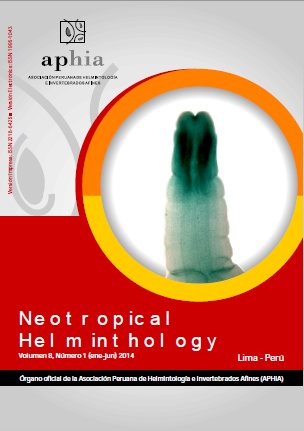COMMUNITY OF METAZOAN PARASITES OF CORVINA DRUM CILUS GILBERTI (ABBOTT, 1899) (PERCIFORMES: SCIAENIDAE) IN THE COASTAL ZONE OF CHORRILLOS, LIMA, PERU
DOI:
https://doi.org/10.24039/rnh201481908Keywords:
Cilus gilberti, parasite community, corvina drum, macroparasite, zoonosisAbstract
The corvina drum Cilus gilberti (Abbott, 1899) (Sciaenidae), is a demersal and carnivorous species distributed from Sechura Bay (Peru) to Lot (Chile). This work represents a qualitative and quantitative analysis of C. gilberti parasite communities in Peru, with the aim of assessing their metazoan parasite community in the coastal area of Chorrillos, Lima, Peru. One hundred and three specimens of C. gilberti were acquired in Fishing Terminal Chorrillos, Lima, Peru from August to October 2011. The parasites were collected, fixed, preserved and quantified using standard procedures. Atotal of 257 parasites and 16 parasite species were collected. The highest frequency of dominance and relative dominance were three endoparasites: Diphyllobothrium pacificum, a Philometridae species and Corynosoma obtuscens. The prevalence and mean abundance of D. pacificum were correlated with the total length of the host. Parasitefauna of C. gilberti showed relatively high values of alpha diversity indices but indices of dominance had low values. Nonparametric estimators indicated no effort to increase the sampling of fish hosts. The index of interactivity (CC ) showed high values indicating that parasite communities are isolated or non- 50 interactive. The parasite community of C. gilberti did not follow any of the four theoretical models of patterns of abundance-diversity. All parasites recorded, except: Lernanthropus pacificus; Neobrachiella sp.; Helicometra fasciata; Villarrealina peruviana and D. pacificum are considered new records for C. gilberti in Peru. The discovery of the plerocercoid of D. pacificum in corvina drum indicates that this host species has zoonotic potential in the central Peruvian coast. Plagioporus sp. and Raphidascaris sp. are recorded for the first time on the Peruvian coast.
Downloads
Published
How to Cite
Issue
Section
License
Copyright (c) 2021 Neotropical Helminthology

This work is licensed under a Creative Commons Attribution-NonCommercial-NoDerivatives 4.0 International License.
OBJETO: El AUTOR-CEDENTE transfiere de manera TOTAL Y SIN LIMITACIÓN alguna al CESIONARIO los derechos patrimoniales que le corresponden sobre la (s) obra(s) tituladas: xxxxxxxxxxxxxxxx, por el tiempo que establezca la ley internacional. En virtud de lo anterior, se entiende que el CESIONARIO adquiere el derecho de reproducción en todas sus modalidades, incluso para inclusión audiovisual; el derecho de transformación o adaptación, comunicación pública, traducción, distribución y, en general, cualquier tipo de explotación que de las obras se pueda realizar por cualquier medio conocido o por conocer en el territorio nacional o internacional.
REMUNERACIÓN: La cesión de los derechos patrimoniales de autor que mediante este contrato se hace será a título gratuito.
CONDICIONES Y LEGITIMIDAD DE LOS DERECHOS: El AUTOR-CEDENTE garantiza que es propietario integral de los derechos de explotación de la(s) obra(s) y en consecuencia garantiza que puede contratar y transferir los derechos aquí cedidos sin ningún tipo de limitación por no tener ningún tipo de gravamen, limitación o disposición. En todo caso, responderá por cualquier reclamo que en materia de derecho de autor se pueda presentar, exonerando de cualquier responsabilidad al CESIONARIO.
LICENCIA DE ACCESO ABIERTO: El AUTOR-CEDENTE autoriza que manuscrito publicado en La Revista Neotropical Helminthology permanece disponible para su consulta pública en el sitio web https://www.neotropicalhelminthology.com/ y en los diferentes sistemas de indexación y bases de datos en las que la revista tiene visibilidad, bajo la licencia Creative Commons, en la modalidad Reconocimiento-No comercial- Sin Trabajos derivados –aprobada en Perú, y por lo tanto son de acceso abierto. De ahí que los autores dan, sin derecho a retribución económica, a la Asociación Peruana de Helmintología e Invertebrados Afines (APHIA), los derechos de autor para la edición y reproducción a través de diferentes medios de difusión.


 Numero 2 Volumen 19 - 2025 (versión Anticipada)
Numero 2 Volumen 19 - 2025 (versión Anticipada)














































